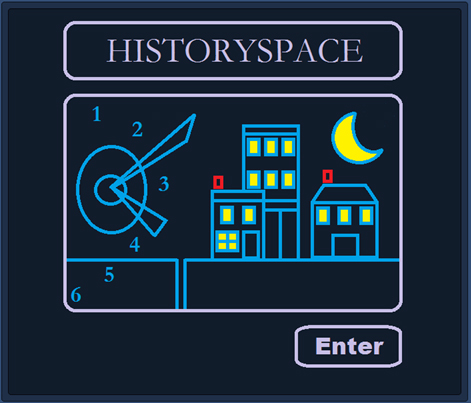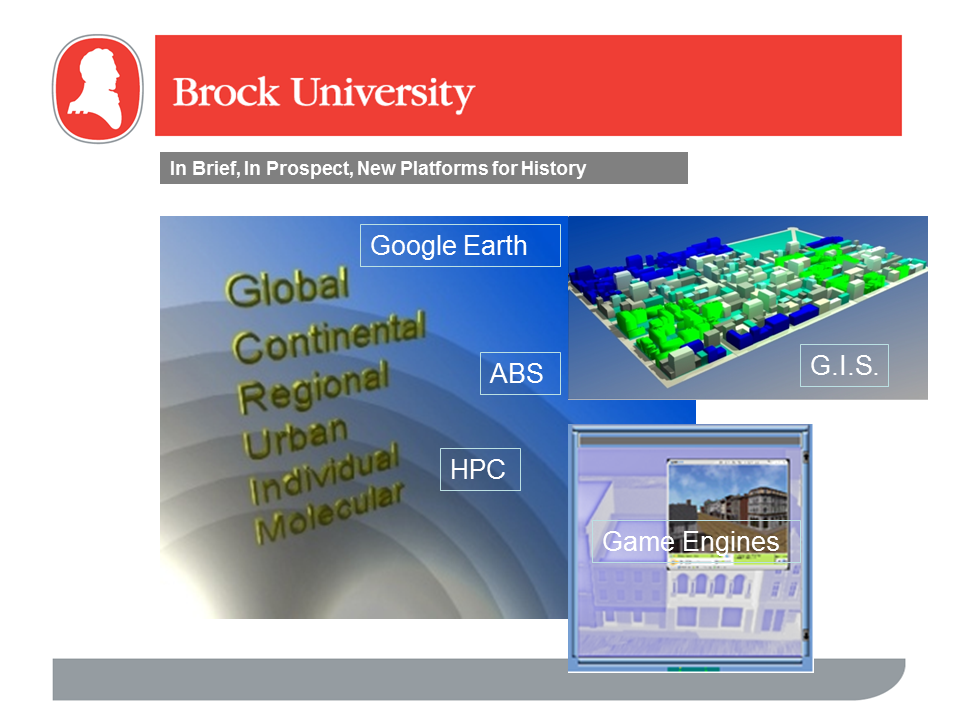Projects
The HistorySpace Project
The rationale for The HistorySpace Project is a simple one. Computation, particularly in recent years, has dramatically expanded the way we can express content. Individuals with computers and access to the Internet can now access free versions of high-end software such as 3D Studio Max and the Unity 3D game engine in order to generate content. While this development opens up remarkable opportunities, it also presents users, and in particular scholars, with important challenges. One important challenge centers on the nature of the containers that scholars will use to order, store and disseminate content. Users cannot store 3D and multi-modal content in books, at least as books have been traditionally conceived and that realization presents scholars with two obvious questions:
• What manner of platform, or platforms, will humanists use to express multi-modal content?
• And what characteristics -- read designs, read workflows -- will scholars use to generate, represent, disseminate and document content?
These are the central questions that drive The HistorySpace Project, The project itself was founded in 2013 and it a collaboration between researchers based at Brock University and Edge Hill University. The project is led by John Bonnett (Department of History, Brock) and Mark Anderson (Department of Computing, Edge Hill). In our work, we operate under the assumption that present and emerging platforms are being shaped by the phenomenon of convergence. In technological contexts, convergence refers to the integration of tools into larger constructs in order to enhance the capacities of users. The smart phone is a well known example of convergence. It brings together multiple tools including the computer monitor, the keyboard, the camera, the calendar, the digital music player, and of course the phone. In our context, we believe emerging scholarly platforms are integrating multiple analytical and expressive tools, including:
• Gaming Engines — A good introductory way to describe game engines is by way of analogy. Game engines can be usefully characterized as "word processors" for virtual worlds. They support the creation and integration of multiple forms of content, be they text, 2D, 3D, 4D, audio, and so on. Game engines are also important because they provide multiple and simultaneous ways to represent space, ranging from cartographic to photo-realistic.
• Geographic Information Systems (GIS) —Geographic Information Systems such as ArcGIS can support multiple tasks, but at base they are all designed to do one thing: combine attribute data, such as a person's ethnicity, with spatial data, such as that person's address. The purpose in so doing is pattern detection. Users employ GIS to locate patterns and statistical connections using space as their organizing framework.
• Agent-Based Simulations (ABS) — Agent-Based Simulations are an important complement to GIS. While GIS is used to locate important patterns and statistical correlations in data, ABS are used to test hypotheses explaining the emergence and persistence of those patterns. In history and the historical sciences, ABS have used to explore topics ranging from the disappearance of the Anasazi in 1300 AD to the Battle of Trafalgar.
• Google Earth, or an Open Source Variant — Google Earth and its proprietary and open source counterparts are important for two reasons. First, they are designed to display content, be natural topography or human activity, at multiple levels of spatial organization. Second, they are designed to support the display of multi-modal content, be it cartographic, photographic or topographic.
• High-Performance Computing (HPC) — HPC is a paradigm of computing that provides computational power orders of magnitude larger than one can obtain on one's desktop. By the end of the decade, HPC clusters will be on-line that provide exa-scale levels of computing, systems that can make one quintillion calculations on one quintillion bytes of data per second. Computer clusters situated in networks such as SHARCNET achieve this power by networking hundreds and thousands of computing processors together. In concrete terms, HPC systems have been used to create digital cities with as many as a million inhabitants. They have also been used to simulate the behavior of galaxies and the human cell.
If convergence does indeed prove to be the dynamic structuring the evolution of 21st-century digital platforms, scholars will soon have access to more computational and expressive power than humans have ever enjoyed before. They will be able to express content at any level of spatial organization, ranging from the molecular and microbial to the planetary and galactic (The forthcoming computer game No Man's Sky offers a foretaste of what we mean). Scholars will also be able to represent and simulate content in time, at increments ranging from nano-seconds to millennia and more.
However, while convergence offers impressive opportunities, its operation will also present important challenges to scholars seeking to structure and document content and create narratives. We are trying to think through those challenges. We discovered early on, however, that there is no way we can offer a comprehensive set of solutions to the design challenges arising from the convergence of all five applications. So, while we have used convergence to structure our thinking, we have also reduced the scope of our exploration to exploring the implications of integrating two applications: Game Engines and GIS. We also realized that it would be silly to anticipate the design needs and solutions for the entire discipline of history. The discipline is too large, and the expressive and analytical needs of its practitioners too many and too diverse to accommodate a limited set of applications and expressive conventions.
For that reason, we limited the scope of our thinking to the practical and expressive needs of two domains: social history and architectural history. We selected these two sub-disciplines because researchers in each, perhaps more than any other counterpart, have done the most to specify their user requirements for present and emerging digital technologies. Our exploration was constrained by a final factor: scale. Rather than trying to meet the design challenges associated with narratives that shift between macro- and micro-levels of spatial organization, say between viewing the North Atlantic in one instance and then an individual's home in another, we opted to focus on a scale of space: the city. Our rationale in so doing was that cities are an obvious focus of interest to both social and architectural historians.








